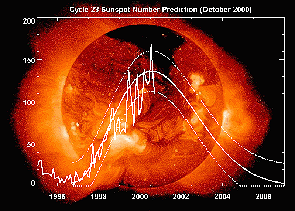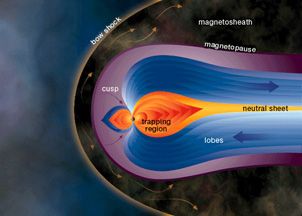The IMF is represented by the blue arcs in the picture above. This picture shows the spiral nature of the IMF.
Click on image for full size
NASA
IMF
IMF stands for Interplanetary Magnetic Field. It is another name for the Sun's magnetic field.
The Sun's magnetic field is huge! It goes beyond any of the planets. The Sun's magnetic field got its name because of that. We call the Sun's magnetic field the Interplanetary Magnetic Field meaning it has all of the planets within it.
The magnetic field of the Sun is carried by the solar wind which comes out from the Sun. The solar wind and magnetic field are twisted into a spiral by the Sun's rotation.
Eventually the solar wind and IMF encounter interstellar space. The boundary between space dominated by the Sun (or the heliosphere) and interstellar space is called the heliopause.
You might also be interested in:

The force of magnetism causes material to point along the direction the magnetic force points. As shown in the diagram to the left, the force of magnetism is illustrated by lines, which represent the force.
...more
The solar wind is formed as the Sun's top layer blows off into space, carrying magnetic fields still attached to the Sun. Gusts form in the solar wind associated with violent events on the Sun. Particles
...more
When evaporation begins, the gas is propelled from the nucleus at supersonic speed (depicted by arrows in the figure). Because of the low gravity in space, this means that the molecules from the nucleus
...more
The Ulysses space probe has begun to investigate the Sun during solar maximum. Ulysses is now observing the South pole of the Sun. Ulysses has passed this way before, but during solar minimum. "Ulysses
...more
A magnetometer is an instrument for measuring magnetic fields. Many spacecraft carry magnetometers to measure the magnetic fields around planets. When a spacecraft makes those measurements, what do the
...more
Earth's magnetosphere shields our planet from most of the solar wind. Some solar wind particles do leak in and combine with ions escaping from the top of Earth's atmosphere to populate the magnetosphere
...more
Spacecraft help us observe and measure space weather. We also make some kinds of space weather measurements from the surface of Earth. Satellites are better for some kinds of observations. However, observations
...more















